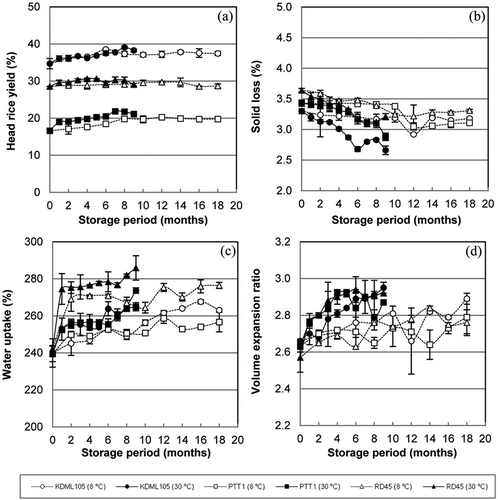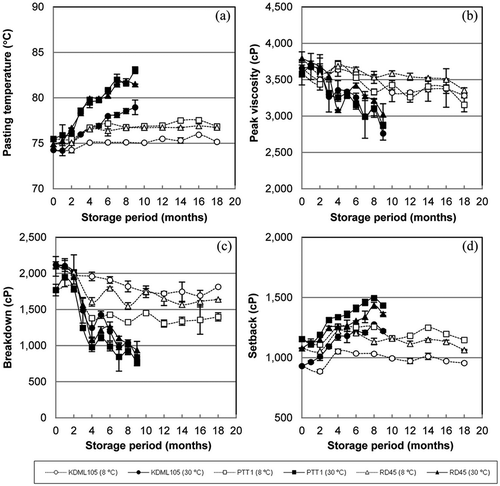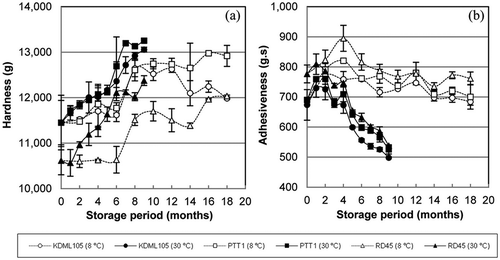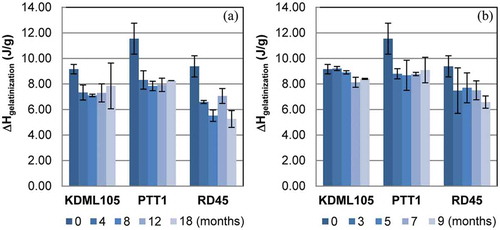ABSTRACT
The objectives of this study were to monitor the changes in rice properties during aging and to compare kinetic parameters related to some of those changes. Paddy of three low amylose rice varieties was stored at ambient (30 ± 2ºC) and chilled (8 ± 2ºC) temperatures for 9 and 18 months, respectively. Aging led to a decrease in solid loss, peak viscosity, breakdown, and adhesiveness and an increase in head rice yield, minimum cooking time, water uptake, volume expansion, pasting temperature, final viscosity, through viscosity, setback, and hardness. Low temperature storage efficiently retarded those changes. Data of the time-dependent changes in hardness, adhesiveness, pasting temperature, peak viscosity, and breakdown of all samples stored at 30°C were fitted well with the first-order fractional conversion kinetic model (R2 = 0.77 – 0.98). Higher storage temperature resulted in greater rate constant (k; up to 9 times higher) of those changes.
Introduction
Low amylose rice is regionally preferred for consumption as cooked rice due to its soft and sticky texture. However, cooked aged rice usually has greater hardness and reduced stickiness. Rice aging involves a number of chemical changes, leading to the changes in physical and functional properties. These include the changes in textural properties, pasting properties, thermal properties, and cooking quality.[Citation1–Citation4] Mechanisms of rice aging are presumably related to the qualitative changes in starch, protein, and lipids. An increase in protein molecular weight may decrease swelling power of starch granule, and eventually result in textural changes of cooked rice.[Citation5–Citation7] Two pathways of lipid modification may occur during aging. The first pathway is the hydrolysis of triglycerides, yielding free fatty acids. Proportion of amylose-lipid complex may thus increase, leading to increasing hardness. The second pathway is autoxidation of lipids. Hydroperoxides obtained from such reactions may accelerate oxidation of protein. Moreover, volatile carbonyl compounds produced from the autoxidation generate off odor.[Citation6] Starch comprises mainly amylose and amylopectin. In addition to enhanced complexation between amylose and lipid during aging, changes in amylose:amylopectin ratio and amylopectin chain length distribution may be observed due to amylase activity.[Citation8]
External factors, e.g., temperature, moisture content, storage time and packaging, play an important role in either slowing down or accelerating rice aging. At higher storage temperatures, changes in starch, lipid, and protein components have been shown to be more pronounced.[Citation9] Zhou et al.[Citation1] monitored aging of three rice varieties; Koshihikari, Kyeema, and Doongara, at 4 and 37°C for 16 months. They reported that water uptake during cooking, as well as hardness and cohesiveness of the cooked rice increased while solid loss and adhesiveness of the cooked rice decreased during storage. Higher storage temperature induced greater extent of those changes. Perez and Juliano[Citation10] reported that, for rice samples stored at 15ºC, aging effects were most significant during the first three to four months of storage. Park et al.[Citation3] followed the changes in physicochemical properties of Japonica rice stored at 4, 20, 30, and 40°C for 4 months. Reduction in breakdown and adhesiveness with elevation in hardness, cohesiveness, and set back were observed during aging, corresponding to the results from other studies. They also found that textural properties of cooked rice prepared from the 40°C/1 month aged rice were similar to those prepared from the 4°C/4 month aged rice. Although aging induced observable changes in physicochemical properties, it did not induce quantitative changes in the chemical composition of rice kernels.[Citation11] Villareal et al.[Citation12] and Indudhara Swamy et al.[Citation13] showed that gross change in starch, amylose, and protein content of aged rice were minimal. Many researchers have studied aging of rice at different temperatures and concluded that slower change was observed at lower storage temperatures.[Citation1,Citation3,Citation5,Citation9,Citation14,Citation15] Nevertheless, none has compared the rate of changes in rice properties during aging at different temperatures. Therefore, the objectives of this study were to determine changes in rice properties at ambient and chilled temperatures and determine aging kinetics parameters related to changes in some functional properties.
Materials and methods
Materials
Paddy of low amylose rice cv.Khao Dawk Mali 105 (KDML105; 11.2% amylose) and Rice Department 45 (RD45; 12.6% amylose) were obtained from Agricultural Co-op Prachantakam. Pathumthani 1 (PTT1; 10.5% amylose) paddy was obtained from Pathumthani Rice Research Center, Thailand.
Sample preparation
The rice paddy, 10.8–12.8% moisture, was packed in plastic woven sacks (1.5 kg/sack). Two conditions of storage were used, 8 ± 2°C and 80% relative humidity (RH) for 18 months and 30 ± 2°C and 70% RH for 9 months. The rice qualities were determined at an interval of 2 months for 8 ± 2°C storage and 1 month for 30 ± 2°C storage.
Determination of head rice yield and color of milled rice
Head rice yield was determined by the method of Thai Agricultural Standard (TAS) 4004.[Citation16] One hundred and twenty-five grams (125 g) of paddy were dehusked twice by a dehusking machine with three rollers (Sinthavee garage, Lopburi, Thailand). The brown rice was then polished (Polisher, Sinthavee garage, Lopburi, Thailand) for 20 s to obtain milled rice. A roller sizing equipment was used to separate broken rice kernels from head rice kernels and whole rice kernels. Head rice yield was calculated from Eq. (1). The determination was done in duplicate.
The color of milled rice was measured using a Chroma meter (model CR400 series, Konica Minolta, Tokyo, Japan). The color parameters were reported in Hunter L, a, b system. Whiteness index were calculated from Eq. (2).[Citation17] The measurement was performed in three replicates.
Determination of cooking quality and textural properties
Cooking quality was evaluated with the method modified from Gujral and Kumar[Citation18] and Soponronnarit et al.[Citation2] The measurement was done in duplicate. One gram (1 g) of milled rice kernels was boiled at 99 ± 1°C in 10 mL of distilled water in a test tube. The sample was retrieved at an interval of 1 min and pressed between two microscope glass slides. The time required to fully cook rice kernels was recorded as minimum cooking time. The sample was held in boiling water at the minimum cooking time was then decanted. The liquid was transferred into pre-weighted aluminum can and dried at 105°C for 24 h in a hot-air oven. Solid loss was calculated from Eq. (3).
Cooked rice was drained and weighed. Water uptake was calculated using Eq. (4).
where WUC and WC are the weight of uncooked and cooked rice kernels, respectively. The volume expansion ratio was the volume of cooked rice kernels divided by the volume of uncooked rice kernels. For textural analysis, cooked rice was prepared by steaming at the minimum cooking time. After the rice was fully cooked, it was held in an aluminum bowl for additional 10 min. The sample was then left to cool down for 30 min at ambient temperature before textural measurement. Textural properties of cooked rice samples were determined using the texture analyzer (TA; TA.XT plus Texture Analyser, Stable Micro Systems, Ltd., UK), with the modified method of Champagne et al.[Citation19] One gram of cooked rice samples was weighed and arranged in a single-grain layer on the platform of the TA. The sample was compressed using P100 probe at a speed of 1 mm/s. The measurement was done in 10 replicates.
Determination of pasting properties and thermal properties of rice flour
Milled rice samples were ground and sieved through a 100-mesh sifter. Pasting properties of rice flour samples were determined by a rapid visco analyzer (RVA; Model 4D, Newport Scientific, Warriewood, Australia) using standard profile 1. Three grams of rice flour samples (12% moisture) and 25 mL of distilled water were mixed. The flour suspension was held at 50°C for 1 min, and then heated from 50 to 95°C at the rate of 12°C/min. The sample was held at 95°C for 2.5 min and cooled down to 50°C at the rate of 12°C/min. Finally, the sample was kept at 50°C for 2 min. Pasting temperature, peak viscosity, trough viscosity, final viscosity, breakdown, and setback were recorded. The determination was done in duplicate.
The thermal properties of rice flour were determined using a differential scanning calorimeter (DSC; Model Diamond, Perkin-Elmer, Norwalk, CT, USA) with the method modified from Tananuwong and Malila.[Citation20] Rice flour (3.5 mg) was weighed into a large volume stainless steel pan (Perkin-Elmer kit no. 03190218) and distilled water was added to provide flour-to-water ratio of 1:3 (w/w). Sample pans were hermetically sealed and equilibrated overnight at ambient temperature. The sample pan and an empty reference pan were heated from 30 to 135°C at a heating rate of 10°C/min. Onset temperature (To), peak temperature (Tp), conclusion temperature (Tc), the range of gelatinization temperature (ΔTg), and enthalpy of gelatinization (ΔHg) were recorded. The determination was done in duplicate.
Aging kinetics modeling
The experimental data at each storage temperature were fitted using the first-order fractional conversion model (Eq. [5]) that was elaborated in Rizvi and Tong.[Citation21] The model was reported by the researchers to have been used in modeling starch gelatinization that always follows first-order kinetics,[Citation22] in which the reaction rate depends upon reactant concentration. In the first-order fractional conversion model, the measured parameter at any time is a function of its level at the beginning and the end multiplied by the exponential function of the reaction rate constant and the storage time,
where t is storage time (week), A0 and A∞ is the measured parameter at the beginning of storage and that at equilibrium, respectively, and k is the reaction rate constant (week−1). Rizvi and Tong[Citation21] noted that, to apply a first-order kinetics model, the observation time should have been long enough so that the chosen property was no longer change with time. However, in many observed parameters recorded in present study, the changes during aging appeared linearly increasing or decreasing. A zeroth-order reaction model (Eq. [6]), where the progress of the reaction does not depend on the reactant concentration, could probably then be suitably applied:
Therefore, all observed parameters were then fitted using both zeroth- and first-order fractional conversion kinetics model, and the regression coefficient of the fitted models was compared.
Results and discussion
Changes in rice quality during storage
The changes in rice quality during storage were evidenced. Head rice yield increased during storage (). An increase in head rice yield might be due to more agglomeration of starch granule; thus enhancing the endurance of the rice kernels during milling.[Citation2,Citation23] Soponronnarit et al.[Citation2] determined head rice yield of Khao Dawk Mali 105 rice (KDML105) that was stored at ambient temperature for 6 months. The authors found that head rice yield increased within the first 3 months and decreased afterward. The whiteness index of the samples decreased during aging (figure not shown). Decreasing whiteness index during storage could arise from Maillard reaction.[Citation3,Citation24] Park et al.[Citation3] investigated whiteness of milled Japonica rice during storage at 4, 20, 30, and 40°C for 4 months. They found that, at similar aging time, higher storage temperatures yielded rice with less whiteness. For both storage temperatures, minimum cooking time of KDML105 and RD45 increased while that of PTT1 was relatively constant (figure not shown). Kaminski et al.[Citation25] investigated cooking time of rice during storage at 0.5, 20, and 35°C for 180 days. They found that cooking time increased after storage and more pronounced effect was observed at higher storage temperature. Consistently, solid loss of all samples decreased () but water uptake increased during storage at both conditions (). Zhou et al.[Citation1] monitored aging of three rice cultivars (Koshihikari, Kyeema, and Doongara) at 4 and 37°C in air-tight glass bottles for 16 months. Reduction in solid loss was found during low and high temperature storage, corresponding to our results. The complex formation between amylose and free fatty acids occurred during aging might reduce amount of water-soluble starch.[Citation2] It was also noted that the volume expansion ratio of the rice increased during storage (). This could be due to a decrease in grain adhesion that, in turn, allowed cooked rice to expand more freely.[Citation26]
Figure 1. Changes of rice quality during storage: A: head rice yield; B: solid loss; C: water uptake; and D: volume expansion ratio.

Changes in the textural properties of sample during storage for both storage conditions are shown in . The hardness of the sample increased (), whereas adhesiveness decreased () with storage time. Those changes could be related to enhanced formation of amylose-lipid complexes and increasing protein molecular weight.[Citation1,Citation27,Citation28] Toshihisa and Naganori[Citation29] showed that the proteins at the external layer of aged rice grain were oxidized which caused an increase in larger protein molecules (48-kDa protein) to a certain extent. A concurrent increase in cooked rice hardness and a decrease in stickiness-to-hardness ratio of cooked rice were also observed. The researchers also showed that oxidation promotes intermolecular disulfide linkages of rice treating rice flours with oxidizing agent. They observed a decrease in low molecular weight proteins and an increase in higher molecular weight proteins in oxidized flours. The results from our study were consistent with those reported earlier. An increase in hardness with a decrease in adhesiveness of cooked rice prepared from aged rice was reported in previous studies.[Citation1,Citation3] Greater changes were found at higher storage temperature.
During storage at both temperatures, pasting temperature increased while peak viscosity and breakdown decreased (–). Our results were in an agreement with those previously reported.[Citation28,Citation30,Citation31] Changes in pasting properties during aging could be related to increasing molecular weight of rice protein as previously stated, resulting in the formation of large and strong protein networks.Those networks might retard water absorption and cause limited swelling of starch granules.[Citation7] Setback of sample increased (). According to the study of Paraginski et al.,[Citation32] the setback of maize flour increased after storage was due to the interaction between protein and starch and the increase in disulfide linkages in protein. It is important to note that higher temperature condition caused greater rate of all changes (–).
Figure 3. Pasting properties of rice during storage at 8 and 30°C: A: pasting temperature; B: peak viscosity; C: breakdown; and D: setback.

For the storage at low and ambient temperatures, onset temperature of flour from PTT1 and RD45, peak temperature of flour from PTT1 and conclusion temperature of all samples slightly changed after storage (figure not shown). However, enthalpy of gelatinization of the PTT1 and RD45 samples decreased ( and ) during storage at both temperatures. This could be due to the formation of large and strong protein networks as explained earlier. The network possibly retarded water absorption of starch granules causing the gelatinization enthalpy to decrease.[Citation20] Teo et al.[Citation33] studied the thermal properties of rice flour after storage at 25, 35, and 45°C for 14 weeks. They found that both temperature and time of storage affected the thermal properties. Onset temperature, peak temperature, and conclusion temperature increased with increasing storage period. Higher storage temperature had more pronounced effect on the properties.
Aging kinetics modeling
To obtain aging kinetics model parameters, all observed data were fitted using Eqs. (5) and (6) as detailed in the materials and methods section and the regression coefficients were compared. In the process of model fitting, the first-order fractional conversion kinetic model was applied to fit the experimental data at 30ºC to obtain A0 and A∞. Both parameters were then applied in the fitting of the observation data at 8ºC. By this way, the rate constant (k) at each storage temperature can be compared rationally. The same set of observation data was then fitted using the zeroth-order kinetics model. As zeroth-order kinetics model is basically a linear model, no A∞ was necessary for the model fitting.
It is noted that only five attributes gave a reasonably high R2 (R2 > 0.70), thus, shown in . It was observed that A0 or the quality at the beginning of aging determined by both models came in close proximity. Zeroth-order kinetics model was better for the explanation of changes in adhesiveness, hardness, and peak viscosity of rice stored at 30°C. Meanwhile, the first-order fractional conversion kinetic model was more suitable for the explanation of changes in pasting temperature and breakdown of rice stored at 30°C.Changes in the five attributes at 8°C storage temperature were better explained using the first-order fractional conversion kinetic model with higher R2. Nevertheless, only the models explaining changes in three pasting attributes; pasting temperature, peak viscosity, and breakdown, fitted reasonably well with an R2 more than 0.5. When comparing the rate constant related to the first-order fractional conversion kinetic model for changes at both temperatures, it could be drawn that the reduction rate in peak viscosity and breakdown of the samples stores at 30°C was 4 to 6 times greater than that of the samples stored at 8°C. For the increase in pasting temperature, the rate of change at 30°C was approximately 8 to 9 times that at 8°C.
Table 1. Kinetics model parameters for changes in rice and flour properties during storage at 8 and 30°C.
Conclusion
Low temperature storage of rice paddy caused a slower change in rice quality. As storage proceeded, a decrease in solid loss, peak viscosity, breakdown, and adhesiveness and an increase in head rice yield, minimum cooking time, water uptake, volume expansion, pasting temperature, final viscosity, through viscosity, setback, and hardness were observed. By applying the first-order fractional conversion kinetic model to the changes in properties of rice stored at 8 and 30°C, differences in rate of change in rice properties during aging were revealed. Only three pasting attributes, pasting temperature, peak viscosity, and breakdown, could be fitted reasonably well using the first-order fractional conversion kinetic model. From this study, the rate of change during aging of low amylose rice at 30°C was greater than that aging at 8°C. The values were approximately 4 to 6 times greater for the reduction in peak viscosity and breakdown, and approximately 8 to 9 times higher for pasting temperature.
Funding
The research was funded by National Research Council of Thailand (NRCT) fiscal year 2012 and 2014 (grant number 2555NRCT716 and PRP5705021150) under the management of Agricultural Research and Development Agency (ARDA).
Acknowledgments
The raw material in this study was supported by Pathumthani Rice Research Center and Agricultural Co-op Prachantakam.
Additional information
Funding
References
- Zhou, Z.; Robards, K.; Helliwell, S.; Blanchard, C. Effect of Storage Temperature on Cooking Behaviour of Rice. Food Chemistry 2007, 105, 491–497.
- Soponronnarit, S.; Chiawwet, M.; Prachayawarakorn, S.; Tungtrakul, P.; Taechapairoj, C. Comparative Study of Physicochemical Properties of Accelerated and Naturally Aged Rice. Journal of Food Engineering 2008, 85, 268–276.
- Park, C.E.; Kim, Y.S.; Park, K.J.; Kim, B.K. Changes in Physicochemical Characteristics of Rice During Storage at Different Temperatures. Journal of Stored Products Research 2012, 48, 25–29.
- Faruq, G.; Prodhan, Z.H.; Nezhadahmadi, A. Effects of Ageing on Selected Cooking Quality Parameters of Rice. International Journal of Food Properties 2015, 18(4), 922–933.
- Ramesh, M.; Bhattacharya, K.R.; Mitchell, J.R. Developments in Understanding the Basis of Cooked-Rice Texture. Food Science and Nutrition 2000, 40(6), 449–460.
- Zhou, Z.; Robards, K.; Helliwell, S.; Blanchard, C. Ageing of Stored Rice: Changes in Chemical and Physical Attributes. Journal of Cereal Science 2002, 35, 65–78.
- Likitwattanasade, T.; Hongsprabhas, P. Effect of Storage Proteins on Pasting Properties and Microstructure of Thai Rice. Food Research International 2010, 43, 1402–1409.
- Patindol, J.; Wang, Y.-J.; Jane, J.-I. Structure-Functionality Changes in Starch Following Rough Rice Storage. Starch/Stärke 2005, 57, 197–207.
- Chrastil, J. Protein-Starch Interactions in Rice Grains. Influence of Storage on Oryzenin and Starch. Journal of Agricultural and Food Chemistry 1990, 38(9), 1804–1809.
- Perez, C.M.; Juliano, B.O. Texture Changes and Storage of Rice. Journal of Texture Studies 1981, 12, 321–333.
- Kamonrat, T.; Sanguansri, C. Influence of Acid Treatment on Physicochemical Properties of Aged Rice Flour. International Journal of Food Properties 2016, 19(9), 2074–2086.
- Villareal, R.M.; Resurreccion, A.P.; Suzuki, L.B.; Juliano, B.O. Changes in Physicochemical Properties of Rice During Storage. Starch/Stärke 1976, 28, 88–94.
- Indudhara Swamy, Y.M.; Sowbhagya, C.M.; Bhattacharya, K.R. Changes in the Physicochemical Properties of Rice with Aging. Journal of the Science of Food and Agriculture 1978, 29, 627–639.
- Jirathumkitkul, P. Effect of storage conditions on quality of brown rice. Mater thesis, Graduate School, Kasetsart University, Bangkok, Thailand, 1998; 140.
- Butta, M.S.; Anjuma, F.M.; Salim-ur-Rehmana; Tahir-Nadeema, M.; Sharifa, M.K.; Anwerb, M. Selected Quality Attributes of Fine Basmati Rice: Effect of Storage History and Varieties. International Journal of Food Properties 2008, 11(3), 698–711.
- Thai Agricultural Standard (TAS) 4004. Rice. National Bureau of Agricultural Commodity and Food Standards: Bangkok, Thailand, 2012.
- Prasert, W.; Suwannaporn, P. Optimization of Instant Jasmine Rice Process and Its Physicochemical Properties. Journal of Food Engineering 2009, 95, 56–61.
- Gujral, H.S.; Kumar, V. Effect of Accelerated Aging on the Physicochemical and Textural Properties of Brown and Milled Rice. Journal of Food Engineering 2003, 59, 117–121.
- Champagne, E.T.; Lyon, B.G.; Bong, K.M.; Vinyard, B.T.; Bett, K.L.; Barton, F.E.; Webb, B.D.; McClung, A.M.; Moldenhauer, K.A.; Linscombe, S.; McKenzie, K.S.; Kohlwey, D.E. Effect of Postharvest Processing on Texture Profile Analysis of Cooked Rice. Cereal Chemistry 1998, 75(2), 181–186.
- Tananuwong, K.; Malila, Y. Changes in Physicochemical Properties of Organic Hulled Rice During Storage Under Different Conditions. Food Chemistry 2011, 125, 179–185.
- Rizvi, A.F.; Tong, C.H. Fractional Conversion for Determining Texture Degradation Kinetics of Vegetables. Journal of Food Science 1997, 62(1), 1–7.
- Lund, D.B. Kinetics of Physical Changes in Foods. In Physical and Chemical Properties of Food; American Society of Agricultural Engineers: Michigan, USA, 1986; 367.
- Juliano, B.O. Rice: Chemistry and Technology. American Association of Cereal Chemists, 1985; 443–524.
- Kim, K.M.; Jang, I.S.; Ha, S.D.; Bae, D.H. Improved Storage Stability of Brown Rice by Coating with Rice Bran Protein. Korean Journal of Food Science and Technology 2004, 36(3), 490–500.
- Kaminski, T.A.; Brackmann, A.; Da Silva, L.P.; Nicoletti, A.M.; Roberto, B.S. Changes in Culinary, Viscoamylographic and Sensory Characteristics During Rice Storage at Different Temperatures. Journal of Stored Products Research 2013, 53, 37–42.
- Bhattacharya, K.R. Rice Quality: A Guide to Rice Properties and Analysis. Woodhead Publishing Limited: Cambridge, UK, 2011; 116–163.
- Sodhi, N.S.; Singh, N.; Arora, M.; Singh, J. Changes in Physicochemical, Thermal, Cooking and Textural Properties of Rice During Aging. Journal of Food Precessing Preservation 2003, 27, 387–400.
- Tulyathan, V.; Leeharatanaluk, B. Changes in Quality of Rice (Oryza Sativa L.) cv. Khao Dawk Mali 105 During Storage. Journal of Food Biochemistry 2007, 31, 415–425.
- Toshihisa, O.; Naganori, O. Studies on Textural and Chemical Changes in Aged Rice Grains. Food Science and Technology Research 2005, 11(4), 385–389.
- Noomhorm, A.; Kongseree, N.; Apintanapong, N. Effect of Aging on the Quality of Glutinous Rice Crackers. Cereal Chemistry 1997, 74, 12–15.
- Zhou, Z.; Robards, K.; Helliwell, S.; Blanchard, C. Effect of Rice Storage on Pasting Properties of Rice Flour. Food Research International 2003, 36, 625–634.
- Paraginski, R.T.; Vanier, N.L.; Berrios, J.D.J.; De Oliveira, M.C.; Elias, M.C. Physicochemical and Pasting Properties of Maize as Affected by Storage Temperature. Journal of Stored Products Research 2014, 59, 209–214.
- Teo, C.H.; Karim, A.A.; Cheah, P.B.; Norziah, M.H.; Seow, C.C. On the Roles of Protein and Starch in the Aging of Non-Waxy Rice Flour. Food Chemistry 2000, 69, 229–236.


